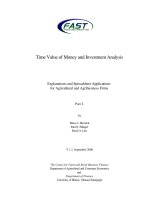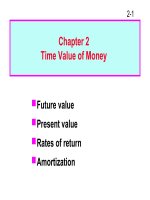FM11 Ch 02 Time Value of Money
Bạn đang xem bản rút gọn của tài liệu. Xem và tải ngay bản đầy đủ của tài liệu tại đây (187.6 KB, 83 trang )
2-1
Future value
Present value
Rates of return
Amortization
Chapter 2
Time Value of Money
2-2
Time lines show timing of cash flows.
CF
0
CF
1
CF
3
CF
2
0 1 2 3
i%
Tick marks at ends of periods, so Time 0
is today; Time 1 is the end of Period 1;
or the beginning of Period 2.
2-3
Time line for a $100 lump sum due at
the end of Year 2.
100
0 1 2 Year
i%
2-4
Time line for an ordinary annuity of
$100 for 3 years.
100 100100
0 1 2 3
i%
2-5
Time line for uneven CFs: -$50 at t = 0
and $100, $75, and $50 at the end of
Years 1 through 3.
100 50 75
0 1 2 3
i%
-50
2-6
What’s the FV of an initial $100 after 3
years if i = 10%?
FV = ?
0 1 2 3
10%
Finding FVs (moving to the right
on a time line) is called compounding.
100
2-7
After 1 year:
FV
1
= PV + INT
1
= PV + PV (i)
= PV(1 + i)
= $100(1.10)
= $110.00.
After 2 years:
FV
2
= FV
1
(1+i) = PV(1 + i)(1+i)
= PV(1+i)
2
= $100(1.10)
2
= $121.00.
2-8
After 3 years:
FV
3
= FV2(1+i)=PV(1 + i)
2
(1+i)
= PV(1+i)
3
= $100(1.10)
3
= $133.10.
In general,
FV
n
= PV(1 + i)
n
.
2-9
Three Ways to Find FVs
Solve the equation with a regular
calculator.
Use a financial calculator.
Use a spreadsheet.
2-10
Financial calculator: HP10BII
Adjust display brightness: hold down
ON and push + or
Set number of decimal places to
display: Orange Shift key, then DISP
key (in orange), then desired decimal
places (e.g., 3).
To temporarily show all digits, hit
Orange Shift key, then DISP, then =
2-11
HP10BII (Continued)
To permantly show all digits, hit
ORANGE shift, then DISP, then .
(period key)
Set decimal mode: Hit ORANGE shift,
then ./, key. Note: many non-US
countries reverse the US use of
decimals and commas when writing a
number.
2-12
HP10BII: Set Time Value Parameters
To set END (for cash flows occuring at
the end of the year), hit ORANGE shift
key, then BEG/END.
To set 1 payment per period, hit 1,
then ORANGE shift key, then P/YR
2-13
Financial calculators solve this
equation:
There are 4 variables. If 3 are
known, the calculator will solve
for the 4th.
.
0
n
i1PV
n
FV =++
Financial Calculator Solution
2-14
3 10 -100 0
N I/YR PV PMT FV
133.10
Here’s the setup to find FV:
Clearing automatically sets everything
to 0, but for safety enter PMT = 0.
Set: P/YR = 1, END.
INPUTS
OUTPUT
2-15
Spreadsheet Solution
Use the FV function: see spreadsheet
in Ch 02 Mini Case.xls.
= FV(Rate, Nper, Pmt, PV)
= FV(0.10, 3, 0, -100) = 133.10
2-16
10%
What’s the PV of $100 due in 3 years if
i = 10%?
Finding PVs is discounting, and it’s
the reverse of compounding.
100
0 1 2 3
PV = ?
2-17
Solve FV
n
= PV(1 + i )
n
for PV:
( )
PV =
FV
1+ i
= FV
1
1+ i
n
n
n
n
( )
PV = $100
1
1.10
= $100 0.7513 = $75.13.
3
2-18
Financial Calculator Solution
3 10 0 100
N I/YR PV
PMT FV
-75.13
Either PV or FV must be negative. Here
PV = -75.13. Put in $75.13 today, take
out $100 after 3 years.
INPUTS
OUTPUT
2-19
Spreadsheet Solution
Use the PV function: see spreadsheet.
= PV(Rate, Nper, Pmt, FV)
= PV(0.10, 3, 0, 100) = -75.13
2-20
Finding the Time to Double
20%
2
0 1 2 ?
-1
FV = PV(1 + i)
n
$2 = $1(1 + 0.20)
n
(1.2)
n
= $2/$1 = 2
nLN(1.2) = LN(2)
n = LN(2)/LN(1.2)
n = 0.693/0.182 = 3.8.
2-21
20 -1 0 2
N I/YR PV PMT FV
3.8
INPUTS
OUTPUT
Financial Calculator
2-22
Spreadsheet Solution
Use the NPER function: see
spreadsheet.
= NPER(Rate, Pmt, PV, FV)
= NPER(0.20, 0, -1, 2) = 3.8
2-23
Finding the Interest Rate
?%
2
0 1 2 3
-1
FV = PV(1 + i)
n
$2 = $1(1 + i)
3
(2)
(1/3)
= (1 + i)
1.2599 = (1 + i)
i = 0.2599 = 25.99%.
2-24
3 -1 0 2
N I/YR PV PMT FV
25.99
INPUTS
OUTPUT
Financial Calculator
2-25
Spreadsheet Solution
Use the RATE function:
= RATE(Nper, Pmt, PV, FV)
= RATE(3, 0, -1, 2) = 0.2599









